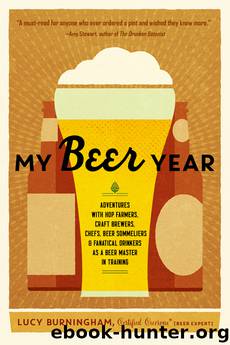My Beer Year by Lucy Burningham

Author:Lucy Burningham
Language: eng
Format: epub
Publisher: Shambhala
Ben moved between the brew deck and other parts of the brewery at an exhausting pace. I tried to stay within conversation distance without getting in his way.
“You probably already know this,” he said, before pushing some buttons and peering at a gauge, “but we’re mimicking the German practice of step infusion mashing.”
He explained how enzymes break starches into sugars, and that two types of enzymes are key for brewing: alpha and beta amylase. Each one creates different types of sugars and works at different temperatures. By bringing the mash temperature up in “steps,” you can activate both kinds of amylase, which helps create a customized wort filled with variable sugars, some of which the yeast will consume and some of which the yeast will leave behind. Brewers who don’t use step infusions—like me, when I homebrew—try to bring their wort to a temperature that activates both amylases in one swoop. Step or no step, never again would I approach the mash temperature as a general suggestion. Brewing is more like making a piecrust than I initially thought; the temperature of the chilled butter matters to the degree.
At one point, Ben disappeared among the long line of fermenters. When he returned, he was holding a clear plastic pitcher filled with about five inches of an obsidian beer with an espresso-crema-hued head. The beer was a stout, a new recipe that upped the body and hoppiness of the brewery’s Irish dry stout, he said. Ben took a small professional sip then passed the pitcher to me. After his second taste, Ben looked at the floor, paused as though he were thinking, then looked at me and decreed, “Yep. Just right.”
Two times, Ben produced a kit that looked like he was about to test the composition of chemicals in a hot tub. It was called a titration, which he used to measure the concentration of sanitizer solution that cleaned the brewing equipment.
“Standards are for everyone,” he said loudly. I felt like he was talking not to me but to the assistant brewers working in the vicinity.
From the brew deck, I saw one of the brewers let out a loud burst of carbon dioxide from a hose before attaching it to a fermenter. He paused and looked around, which made it seem like he’d made a mistake, but he was actually following protocol and purging oxygen from the valves attached to the fermenter tank before adding the beer, which would help keep the beer tasting fresh.
“See,” Ben said, nodding with approval. “It’s those kinds of practices that keep the beer at quality levels.”
Next thing I knew, Ben looked panicked. He’d just checked the temperature of the mash and something wasn’t right. The mash tun’s mixer paddle wasn’t mixing, which meant sugars from the malt weren’t being evenly extracted.
“It’s just moving around!” Ben yelled at another brewer.
Three of them started attending to the gleaming steel vessel, moving through steam to reach into the small hatch that provided access to the mash and the paddle. I knew they were facing the possibility of a large batch of beer gone wrong.
Download
This site does not store any files on its server. We only index and link to content provided by other sites. Please contact the content providers to delete copyright contents if any and email us, we'll remove relevant links or contents immediately.
| Beer | Cocktails & Mixed Drinks |
| Coffee & Tea | Homebrewing, Distilling & Wine Making |
| Juices & Smoothies | Wine & Spirits |
Whiskies (Collins Gem) by dominic roskrow(42215)
101 Whiskies to Try Before You Die by Ian Buxton(42183)
Whiskies Galore by Ian Buxton(40334)
Craft Beer for the Homebrewer by Michael Agnew(17447)
Right Here, Right Now by Georgia Beers(3497)
Not a Diet Book by James Smith(2726)
Water by Ian Miller(2584)
The Coffee Dictionary by Maxwell Colonna-Dashwood(2531)
Kitchen confidential by Anthony Bourdain(2306)
Coffee for One by KJ Fallon(2008)
Smuggler's Cove: Exotic Cocktails, Rum, and the Cult of Tiki by Martin Cate & Rebecca Cate(1979)
Beer is proof God loves us by Charles W. Bamforth(1921)
Superfood Smoothie Bowls: Delicious, Satisfying, Protein-Packed Blends that Boost Energy and Burn Fat by Chace Daniella(1904)
Talking as Fast as I Can by Lauren Graham(1832)
Bourbon: A Savor the South Cookbook by Kathleen Purvis(1791)
A Short History of Drunkenness by Forsyth Mark(1720)
Eat With Intention by Cassandra Bodzak(1688)
Cocktails for the Holidays by Editors of Imbibe magazine(1626)
Colombia Travel Guide by Lonely Planet(1611)
